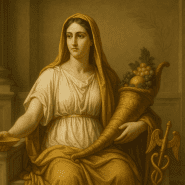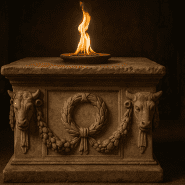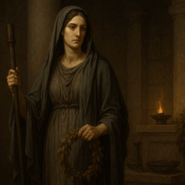RomanMythology.com is built on a foundation of historical scholarship, archaeological research, and primary classical texts. Every article draws from authoritative academic sources to ensure accuracy, clarity, and consistency.
The goal is to present ancient material in a modern, readable form while staying faithful to the original traditions, rituals, and literary accounts found in the ancient world.
Primary Classical Sources
The core of Roman mythological knowledge comes from the surviving works of Roman and Greek authors whose writings shaped the ancient understanding of the gods, heroes, and festivals. These texts form the historical backbone of the site.
Major primary sources used across the site include:
- Aeneid by Virgil
- Metamorphoses by Ovid
- Fasti by Ovid
- Natural History by Pliny the Elder
- Roman History by Livy
- On the Nature of the Gods by Cicero
- Theogony and Works and Days by Hesiod
- Library (Bibliotheca) by Apollodorus
- Hymns, fragments, and inscriptions preserved in the Corpus Inscriptionum Latinarum
These works provide firsthand accounts of rituals, divine attributes, mythological narratives, and cultural practices.
Secondary Academic Sources
Modern historical analysis helps contextualize ancient material, compare variations across regions, and provide updated interpretations based on archaeological findings. The following types of secondary sources inform articles throughout the site:
- Peer-reviewed journals specializing in Classical Studies, Ancient History, and Mediterranean Religions
- Archaeological reports from museum institutions and excavation teams
- Academic encyclopedias such as the Oxford Classical Dictionary
- Classical mythology textbooks and handbooks used in university-level courses
- Publications from major university presses (Oxford, Cambridge, Harvard, Princeton)
Examples of influential modern scholars whose interpretations often shape mythological analysis include Mary Beard, Walter Burkert, H. J. Rose, and Robert Turcan.
Museum and Archaeological References
To ensure accuracy in visual descriptions and object interpretations, RomanMythology.com frequently references materials from:
- The British Museum
- The Louvre Museum
- The Getty Museum
- The Metropolitan Museum of Art
- Museo Nazionale Romano
- Uffizi Gallery
- Vatican Museums
Whenever an image is based on or inspired by historical artwork, the caption includes the original museum’s information and the Wikimedia Commons citation, as applicable.
Epigraphic and Ritual Sources
Because Roman religion relied heavily on temples, public ceremonies, and priestly records, the site also refers to:
- Votive inscriptions
- Funerary tablets
- Calendar fragments such as the Fasti Antiates
- Archaeological site records of temples, shrines, altars, and sacred groves
- Scholarly reconstructions of Roman rites and priesthood traditions
These sources help clarify how each deity was worshipped and how rituals functioned within Roman society.
Modern Interpretative Resources
To support accessibility and a deeper understanding of ancient material, additional sources include:
- Modern translations of classical texts
- Commentaries from established classical scholars
- Historical atlases and maps of the ancient Roman world
- Academic courses, lectures, and open university resources on Roman religion
These materials assist in presenting complex topics clearly and cohesively for modern readers.
Commitment to Scholarly Integrity
RomanMythology.com aims to maintain accuracy across all articles by:
- Cross-checking historical claims against multiple sources
- Relying on established academic consensus when available
- Distinguishing clearly between historical accounts, mythological narratives, and modern interpretations
- Updating pages as new archaeological or scholarly information becomes available
This approach ensures that every article remains informative, reliable, and aligned with contemporary scholarship.


